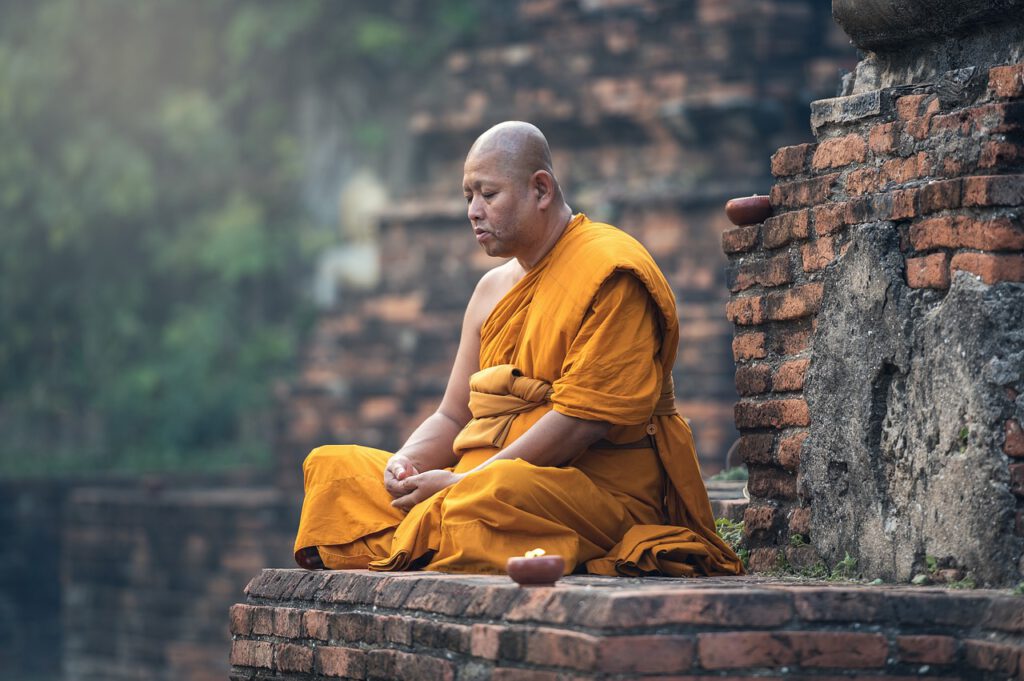
Deep meditation as the goal of meditation. In yoga, the ability to enter deep meditation means leaving the outer koshas with our consciousness. The koshas are our layers of consciousness from the body to our “self”. To know how to enter deep meditation, we must first define what meditation itself is, the difference between deep meditation and the highest form of meditation called samadhi.
From meditation to deep meditation
The state of meditation is clearly defined in Patanjali’s Yoga Sutras. In my quote, I summarize the individual statements into one sentence.
“When the mind focuses on an object of meditation with uninterrupted concentration and the meditator and the object of meditation coincide, meditation arises.”
Patanjali
From this definition, circumstances can be derived that stand for the state of meditation.
- Our mind flows continuously in the direction of a meditation object. A subtle object such as a mantra, the breath or the self is advantageous here. As long as we are connected to our senses such as hearing, tasting, seeing and feeling, we remain on the gross surface of meditation.
- The object of meditation should be chosen individually. In yoga, there are three states of mind. Sattva, tamas and rajas. All living beings strive for sattva, the peaceful and natural core of our mind. Most of the time our mind is in the state of rajas, the constant movement that is also necessary to cope with our everyday life. Tamas is the heavy state of our mind that we experience during sleep, for example. We should therefore be able to assess the disposition of our own mind beforehand in order to enter into deep meditation. We should never go directly from rajas and tamas to sattva, but try to establish balance beforehand in order to then go deeper into meditation, otherwise the state of deep meditation cannot be maintained for long.
- If the mind is slow and relaxed, a mantra can be suitable as an object of meditation
- If the mind is quick and stressful, the breath can be a suitable object for meditation
- Meditator and object coincide. After the state of sustained concentration and thereby gaining depth, we go on to relax our concentration and focus and become more passive. It could be described as continuous “moment to moment awareness” without interruption of thoughts and emotions. These may arise during meditation, but we are already so deeply anchored within ourselves that they just build up and pass by. This is the point where we – the meditator and the meditation object – have already disappeared. At this point we are in meditation, but we are no longer aware of it.
The state of deep meditation in Samadhi
From this point onwards, when we are no longer aware of our body, our senses and ourselves, meditation begins. The duration and stability of this state then leads to deeper states by itself and without our doing. The only thing left for us to do is to let go deeper and deeper and then even of letting go itself.
It can also be explained very well by samadhi, the highest meditative state, which itself also has different levels and states. There are two variants. Samadhi of which we are aware and the state of absolute absorption, a complete loss of control and a fusion with our deepest self. For this state, a meditator takes years or possibly many reincarnations of training until deep-seated attachments have been cleared aside, clearing the way into Samadhi. The good thing is that we don’t have to worry about deep states of meditation. If we have practiced meditation for a long time, we will automatically be able to let go a little more in order to enter deep meditation. What happens from here is beyond our active control. We can prepare the ground so that the seed can grow.
Requirements for deep meditation
For most practitioners, deep meditation experiences require years of training in meditation. It is not impossible that we reach deep meditation by chance. Most of the time, the problem is not getting into deep meditation, but that we want to reach this state again and again afterwards. Our expectations and overly active actions block our path. This is also a completely natural process and it also applies to our meditation practice, just as the stock market price is constantly going up and down.
Factors that promote deep meditation are:
- Emotional Balance
- Regular meditation at the same time in the same place
- Quality of concentration and relaxation
- Let go of expectations and surrender to the process
- Train the process for entering meditation:
- Focus on a meditation object and from here there are two paths:
- Union with the object
- or alignment with the self
Conclusion
Before we engage in deep meditation, we should first learn the clearly defined meditation process and practice it regularly. Once we are in meditation, there is no more active action. From here on, everything happens through the dissolution of the last remnants of resistance to letting go deeply. Emotional balance, quality of concentration, the ability to let go, regularity of meditation practice and increasing the duration of meditation can accelerate the path to deep meditation.
A clear distinction between meditation and deep meditation is therefore difficult to define. A good sign of deep meditation is when we return from meditation with a smile and are amazed at how quickly the time has passed.